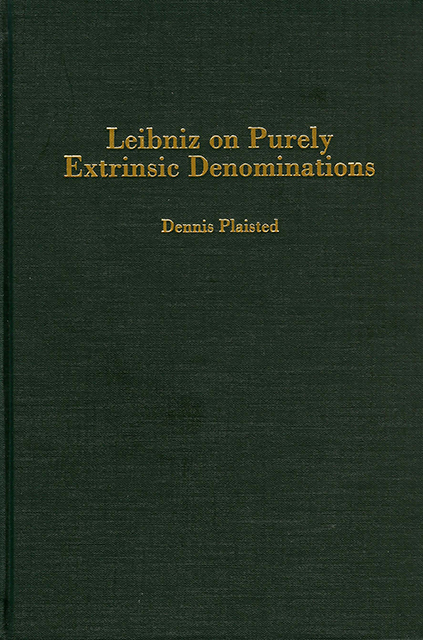Book contents
- Frontmatter
- Dedication
- Contents
- Acknowledgments
- Introduction
- Chapter One Two Views of Purely Extrinsic Denominations
- Chapter Two Truth and Purely Extrinsic Denominations
- Chapter Three Extrinsic Denominations and Where Accidents Are Allowed to Put Their Feet
- Chapter Four Extrinsic Denominations and the Interconnection of All Things
- Chapter Five Extrinsic Denominations and the Foundations of Relations
- Chapter Six Extrinsic Denominations and the Claim that Every Monad Expresses the Universe
- Appendix A Critique of Massimo Mugnai’s Version of NPE
- References
- Abbreviations
- Notes
- Index
Chapter One - Two Views of Purely Extrinsic Denominations
Published online by Cambridge University Press: 25 March 2023
- Frontmatter
- Dedication
- Contents
- Acknowledgments
- Introduction
- Chapter One Two Views of Purely Extrinsic Denominations
- Chapter Two Truth and Purely Extrinsic Denominations
- Chapter Three Extrinsic Denominations and Where Accidents Are Allowed to Put Their Feet
- Chapter Four Extrinsic Denominations and the Interconnection of All Things
- Chapter Five Extrinsic Denominations and the Foundations of Relations
- Chapter Six Extrinsic Denominations and the Claim that Every Monad Expresses the Universe
- Appendix A Critique of Massimo Mugnai’s Version of NPE
- References
- Abbreviations
- Notes
- Index
Summary
I. Introduction
This chapter introduces the two views of NPE that will be the focus of the book. I first describe in more detail the reductionist reading of NPE. Next, I examine the principal lines of textual evidence to which reductionists appeal to support their view. I conclude from this examination that the textual case for reductionism falls well short of being persuasive. Lastly, I set forth the view of NPE that I will defend throughout the book. I maintain that NPE is the assertion that there are no extrinsic denominations of a thing that are not included in the concept of that thing.
II. The Reductionist Reading
In order to get clear on the reductionist interpretation of NPE, we must first understand how reductionists, on Leibniz’s behalf, define the term “extrinsic denomination” and its companion term “intrinsic denomination.” Leibniz never favors us with an explicit definition of either term, but interpreters appear fairly confident that they can reconstruct Leibniz’s understanding of these terms from the way he employs them in various contexts. Mates’s reconstruction of these terms is perhaps the most precise:
In the so-called region of ideas, the counterparts of definite or indefinite descriptions (or abbreviation of such) are denominations. Thus, the ontological status of denominations is that of concepts; in short, denomination is a kind of concept. Now, suppose that a given individual I falls under a given denomination D. If one of the descriptions with which D is correlated makes a reference, via a name or a quantified variable, to some individual or individuals other than I, then D is called an ‘extrinsic denomination’ of I. Otherwise, D is called an ‘intrinsic denomination’ of I.
So, for example, the denomination expressed by the definite description “the father of Solomon” would be an extrinsic denomination of David, as the description refers to an individual (viz., Solomon) other than David; whereas, the denomination expressed by the description “a man” would be an intrinsic denomination of David, since (apparently) the description makes no reference to other individuals.
- Type
- Chapter
- Information
- Leibniz on Purely Extrinsic Denominations , pp. 3 - 12Publisher: Boydell & BrewerPrint publication year: 2002

